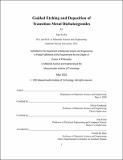Guided etching and deposition of transition metal dichalcogenides
Author(s)
Ke, Jian-An.
Download1197627222-MIT.pdf (7.779Mb)
Other Contributors
Massachusetts Institute of Technology. Department of Materials Science and Engineering.
Advisor
Silvija Gradečak and Jing Kong.
Terms of use
Metadata
Show full item recordAbstract
Two-dimensional (2D) transition metal dichalcogenides (TMDs) with engineered nanopores have been suggested as a promising materials system in membrane and catalysis applications in both the energy and environment fields. Because of its atomic thinness, 2DTMDs are promising candidates for osmosis energy harvesting membranes. Furthermore, the scalable nanopore preparation in MoS₂ crystals provides a more cost-efficient option replacing precious metal-based catalyst for hydrogen evolution reactions catalysis. As an emerging class of semiconductor materials, 2D-TMDs have also attracted attention in electronic and optoelectronic applications, which require lithography processes to define the desired device structure. However, conventional top-down patterning methods rely on temporarily coating a polymer-based resist, which has been found challenging to remove completely and as such is detrimental to 2D devices. Development of a resist-free, guided growth of TMDs is therefore desirable. We demonstrate the guided MoS₂ nanopore formation by engineering structural defects prior to the oxidative annealing process as a scalable and parallel process susceptible to large-scale applications. This process is based on our observation that the nanopore distribution is dramatically different in strained and unstrained MoS₂ crystals, which indicates that nanopore formation reflects distribution of the underlaying structural defects that act as nanopore nucleation sites. Our experimental observations indicate that dislocations in MoS₂ play a role in preferential nanopore nucleation. We further explore guided defect introduction by exposing MoS₂ crystals with electron and laser beams. By varying electron beam exposure dose prior to annealing MoS₂ in air, the nanopore formation density can be controlled. Laser beam exposure, as another beam-based treatment, is also observed to locally enhance the etching of mechanically exfoliated WS₂ under regular wet transferring protocol. Finally, we explored the guided growth on a laser exposed WS₂ template and on electron beam exposed dielectric substrates. We show that MoS₂ preferentially nucleates at laser exposed exfoliated WS₂ crystals, forming WS₂-MoS₂ heterostructure. We then further demonstrate that the MoS₂ growth can be guided to the customized pattern prepared by electron beam exposure on bare SiO₂ substrates. This thesis provides insights into the role of defects during nanopore formation, and new process approaches for guided TMD etching and growth, which serve as a concept generally applicable to other 2D materials systems.
Description
Thesis: Ph. D., Massachusetts Institute of Technology, Department of Materials Science and Engineering, May, 2020 Cataloged from the official PDF of thesis. Includes bibliographical references (pages 114-129).
Date issued
2020Department
Massachusetts Institute of Technology. Department of Materials Science and EngineeringPublisher
Massachusetts Institute of Technology
Keywords
Materials Science and Engineering.